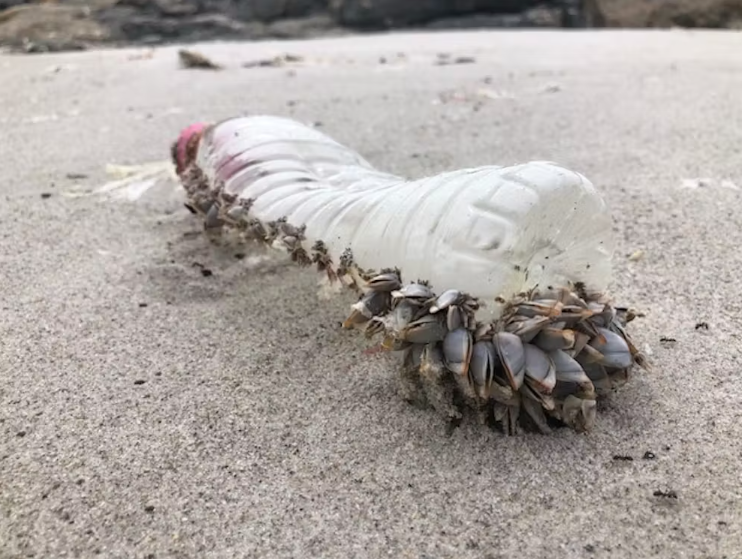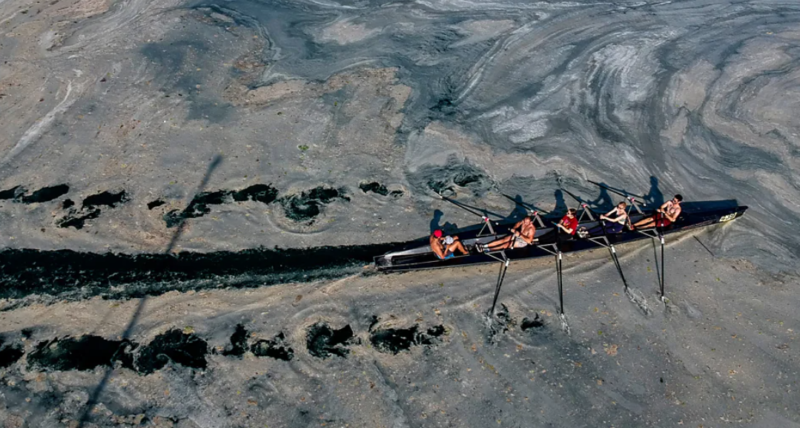The icy and remote landscapes of Antarctica are increasingly polluted and exposed to foreign species drifting to this end of the world via floating ocean debris.
Aware of the threat to this isolated coastline and the unique marine ecosystems of Antarctica, we sought to understand the origins of all this debris. It turns out they travel farther than previously thought.
Using ocean modeling techniques, we have shown that floating objects such as kelp, plastic, and other debris can drift to Antarctica from South America, South Africa, Australia, and New Zealand.
Our new research demonstrates that the coasts of Antarctica are more connected to the lands of the Southern Hemisphere than previously realized. While cold and ice may have previously prevented foreign organisms from colonizing Antarctic waters, these conditions are rapidly changing.
A plastic bottle can serve as a raft for other marine organisms such as barnacles. Hannah Dawson/UTAS
The Unique Antarctic Environment
The coastal waters of Antarctica are extremely cold and mostly covered by sea ice. Nevertheless, these waters host a surprisingly wide range of unique species found nowhere else on Earth.
In recent years, however, non-native species have been discovered in Antarctic waters. They may have arrived on ships, either via the large water tanks on some vessels, by being encrusted on ship hulls, or through drifting ocean debris.
Some of these species, such as kelp, are known to drift from islands just north of the Antarctic continent. But until now, it was unknown if species could reach Antarctica from more distant areas.
We simulated the drifting trajectories of debris such as algae and driftwood. Ceridwen Fraser/University of Otago
Cold Waters as Refuges for Slow-Growing Species
In a warming world, Antarctica is one of the few refuges for slow-growing species that thrive in cold waters. However, if foreign species were to establish themselves in these polar waters, they could compete with native species and radically alter marine ecosystems.
Furthermore, the amount of plastic and other debris in the oceans is increasing each year. This could mean that more non-native species may now reach the frozen continent.
To better understand these risks to native Antarctic species, it is crucial to identify the origins of the debris drifting toward Antarctica.
Southern Ocean Currents
Antarctica is surrounded by a giant ocean current, the Antarctic Circumpolar Current, which flows east around the icy continent, separating it from the warmer waters to the north.
It was long believed that the strength of this eastward current and the associated marked oceanographic fronts isolated the polar continent from drifting objects coming from the north. However, the Antarctic Circumpolar Current is also rich in eddies and subject to powerful storm systems—two elements that could provide potential pathways for floating debris.
Virtually Modeled Drifts
In the past, debris washed ashore on Antarctica’s coasts has been genetically tested to reveal its origin. These analyses confirmed that kelp could drift from the sub-Antarctic islands, including South Georgia Island and the Kerguelen Islands.
However, not all objects can be tested this way. Additionally, only a small portion of the Antarctic coastline is visited by scientists each year, making it impossible to extend such an approach to determine all possible sources.
We thus turned to ocean modeling. We considered possible sources around the islands of the Southern Ocean as well as landmasses farther north, such as Australia, New Zealand, South America, and South Africa.
Ocean currents and surface waves control the drift of objects in the Southern Ocean toward Antarctica. Both influences were incorporated into our model.
In our modeled Southern Hemisphere, we released millions of drifting objects into the ocean and observed their movement around the globe.
We virtually tracked these objects for three years or until they reached the Antarctic coast, if that occurred sooner.
These simulations revealed that floating objects can drift to Antarctica not only from the sub-Antarctic islands but also from New Zealand, Tasmania, South America, and South Africa.
Certainly, only a tiny fraction of the simulated particles actually reach Antarctica, but this occurs annually. This suggests that floating debris and waste regularly arrive on Antarctica’s coasts and have been doing so for some time.
However, with global warming and ice melt, the invasion of foreign organisms could now be more successful.
Warmer Waters and Reduced Sea Ice
Our modeling also allowed us to assess which regions of the Antarctic coastline are most threatened by these non-native species arrivals.
Most of the simulated debris and waste arrived at the tip of the Antarctic Peninsula, which is particularly concerning. This region experiences relatively warm ocean temperatures, allowing the coastline to remain ice-free for extended periods each year.
As we have seen, until now, the cold ocean temperatures and abrasive sea ice served as a natural barrier to exotic species seeking to establish themselves around Antarctica. But with decreasing sea ice at the tip of the Antarctic Peninsula, the chances of non-native species establishing themselves there are increasing.
What Does This Mean for the Future?
Antarctic sea ice has seen a dramatic decline in recent years. Additionally, the Antarctic Peninsula has already warmed more rapidly than most other places around Antarctica, with record temperatures in recent years.
The reduction in sea ice and warming of the Antarctic coastline mean that exotic species could have more opportunities to colonize the frozen continent. Should this occur, we may witness spectacular changes in some of Antarctica’s coastal ecosystems.
Source: the conversation




